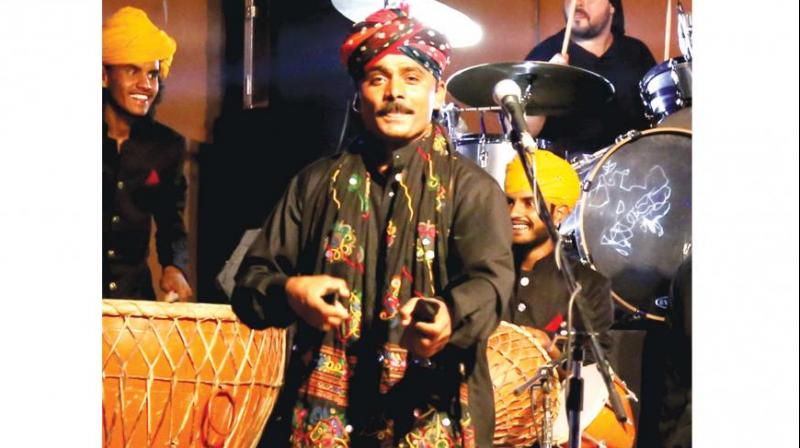With song, dance and drama, Navras festival grips Pink City

The recently concluded 9 day Navras Festival by the State Government funded Jawahar Kala Kendra Jaipur featured a host of interesting dance music and theatre items. The festival started with a percussion ensemble put together by Aneesh Pradhan of Mumbai, entitled “Dhamaal” that set the tone for the events that followed. The next day, Sunday, featured an early morning classical Hindustani vocal recital by Kirana gharana exponent Jayteerth Mevundi who is making waves with his wonderfully “sureela” baritone. The following Sunday, the concluding day of the festival also opened with a Hindustani classical recital on the sitar by Maihar gharana exponent Niladri Kumar; both concerts were in the lush lawns of the institution.
There were several theatre productions “Ek Madhav Baug”, a thought provoking play on homosexuality, and “Elephant in the Room”, a solo enactment, on the first Sunday, followed by three more plays, including an excellent play directed by Naseeruddin Shah entitled “Ismat Appa Ke Naam”. Padmashri Ismat Chugtai was an Urdu writer with an exceptional ability to conjure up a detailed imagery with her words; her works truly lend themselves to being portrayed visually. Naseeruddin Shah has taken three of her short stories, and directed their enactment.
The first story called “Chhui Mui” (Touch me not) was recounted by Heeba Shah, the story of a laborer woman giving birth in a train compartment and how this incident effected the three viewers. The effect of a train was beautifully brought up by the sound of train, and the use of slatted light on the wall behind giving the impression of windows of train compartments. The second story “Mughal Baccha” was recounted by Ratna Pathak Shah, who told the story of a deluded aristocrat who refused to consummate his marriage until his bride lifted up her own “ghunghat”! Again, the visualization by Ratna, making up a “paan” and then slowly chewing it was truly superb. The last short story, enacted by the legendary Naseeruddin Shah was perhaps too long; it dragged somewhat as the plot was fairly predictable – a raunchy maid seducing her elderly old fashioned employer, who married her but then could not stomach her free and easy ways and divorced her; eventually they went back to their old relationship.
Realising that exposure to an artist through a performance whets ones interest, the organizers had sensibly included a session of “Meet the artist” too, after the concert or performance. Students and fans had the opportunity to interact one to one with the play directors, artists and dancers whose performances they had enjoyed the evening before.
The several dance performances included Padmashri Malvika Sarrukkai and her troupe in a production entitled “Thari- The Loom”, inspired by the sari.
One of the more impressionable concerts was by Delhi based vocalist Sonam Kalra and her group, who used the Partition of 1947 as the theme of her concert; “Partition Stories of Seperation”. As she later said, during the interaction at Meet the Artist, the Partition of the Punjab effected millions yet, no one till today really talks about it. Herself effected as both her parents had to re locate, Sonam used poignant dialogues in her songs to bring out the pain of an entire generation “laali akhiyan dee dasdee ai, ki roye assi bhi, te roye tussi bhi” (the redness of the eyes points to crying by both of us, both sides of the border).
The concluding concert of the festival was appropriately by a Rajasthan group, Rajasthan Roots Caravan. They had combined the visual aspect of a performance through fire eaters, and dancers with a powerful singing troupe, including music by the Manganiyars of Jaisalmer. The traditional folk instruments of morchang , khartaals, dhol, nagara and double bamboo flute combined seamlessly with the bass guitar and western drums to create an interesting new sound that combined different singing genres. Bismillah Khan’s open ringing voice, trained to carry without artificial amplification was truly stupendous in its purity; his rendering of “kesariya baalam” literally brought goose bumps.
The Jawahar Kala Kendra premises spread over several acres, and have many different venues and spaces, conducive to different expositions. The tickets were priced very nominally, not more than Rs 100, making the cultural events easily accessible to students and the youth who usually shy from “high brow” culture as it’s usually overpriced and considered elitist. The friendly open ambience that that institution has acquired is a result of considerable effort by the current management, headed by non bureaucrats Pooja Sood and Anuradha Singh. Anuradha Singh reminisced how when she joined the organisation, the guards were instructed to carry whistles and sticks with which to drive away stray students who wanted to sit in the lush green lawns.
She said it took a long time to get through to them that they welcomed the use by youth; from sitting in the lawns they were encouraged to wander through the galleries, hear some free concerts until it has now become a favourite place to hang out in. An excellent, moderately priced café offering Western cuisine called Quaint adds to the charm of the place, as does the more modestly priced Indian Coffee House. Additionally the availability of free Wi Fi is an undeniable plus.
Indeed it was a festival catering to all tastes, curated very imaginatively, and beautifully organised.

